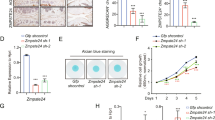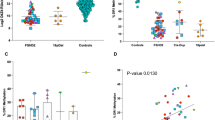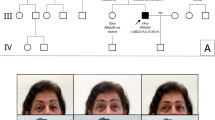Abstract
Restrictive dermopathy (RD) is a rare and extremely severe congenital genodermatosis, characterized by a tight rigid skin with erosions at flexure sites, multiple joint contractures, low bone density and pulmonary insufficiency generally leading to death in the perinatal period. RD is caused in most patients by compound heterozygous or homozygous ZMPSTE24 null mutations. This gene encodes a metalloprotease specifically involved in lamin A post-translational processing. Here, we report a total of 16 families for whom diagnosis and molecular defects were clearly established. Among them, we report seven new ZMPSTE24 mutations, identified in classical RD or Mandibulo-acral dysplasia (MAD) affected patients. We also report nine families with one or two affected children carrying the common, homozygous thymine insertion in exon 9 and demonstrate the lack of a founder effect. In addition, we describe several new ZMPSTE24 variants identified in unaffected controls or in patients affected with non-classical progeroid syndromes. In addition, this mutation update includes a comprehensive search of the literature on previously described ZMPSTE24 mutations and associated phenotypes. Our comprehensive analysis of the molecular pathology supported the general rule: complete loss-of-function of ZMPSTE24 leads to RD, whereas other less severe phenotypes are associated with at least one haploinsufficient allele.
Similar content being viewed by others
Log in or create a free account to read this content
Gain free access to this article, as well as selected content from this journal and more on nature.com
or
References
Navarro CL, De Sandre-Giovannoli A, Bernard R et al: Lamin A and ZMPSTE24 (FACE-1) defects cause nuclear disorganization and identify restrictive dermopathy as a lethal neonatal laminopathy. Hum Mol Genet 2004; 13: 2493–2503.
Smitt JH, van Asperen CJ, Niessen CM et al: Restrictive dermopathy. Report of 12 cases. Dutch Task Force on Genodermatology. Arch Dermatol 1998; 134: 577–579.
Navarro CL, Cadinanos J, De Sandre-Giovannoli A et al: Loss of ZMPSTE24 (FACE-1) causes autosomal recessive restrictive dermopathy and accumulation of Lamin A precursors. Hum Mol Genet 2005; 14: 1503–1513.
Fisher DZ, Chaudhary N, Blobel G : cDNA sequencing of nuclear lamins A and C reveals primary and secondary structural homology to intermediate filament proteins. Proc Natl Acad Sci USA 1986; 83: 6450–6454.
McKeon FD, Kirschner MW, Caput D : Homologies in both primary and secondary structure between nuclear envelope and intermediate filament proteins. Nature 1986; 319: 463–468.
Broers JL, Ramaekers FC, Bonne G, Yaou RB, Hutchison CJ : Nuclear lamins: laminopathies and their role in premature ageing. Physiol Rev 2006; 86: 967–1008.
Prokocimer M, Davidovich M, Nissim-Rafinia M et al: Nuclear lamins: key regulators of nuclear structure and activities. J Cell Mol Med 2009; 13: 1059–1085.
Holtz D, Tanaka RA, Hartwig J, McKeon F : The CaaX motif of lamin A functions in conjunction with the nuclear localization signal to target assembly to the nuclear envelope. Cell 1989; 59: 969–977.
Sinensky M, Fantle K, Trujillo M, McLain T, Kupfer A, Dalton M : The processing pathway of prelamin A. J Cell Sci 1994; 107 (Pt 1): 61–67.
Hennekam RC : Hutchinson-Gilford progeria syndrome: review of the phenotype. Am J Med Genet 2006; 140: 2603–2624.
De Sandre-Giovannoli A, Bernard R, Cau P et al: Lamin a truncation in Hutchinson-Gilford progeria. Science 2003; 300: 2055.
Eriksson M, Brown WT, Gordon LB et al: Recurrent de novo point mutations in lamin A cause Hutchinson-Gilford progeria syndrome. Nature 2003; 423: 293–298.
Agarwal AK, Fryns JP, Auchus RJ, Garg A : Zinc metalloproteinase, ZMPSTE24, is mutated in mandibuloacral dysplasia. Hum Mol Genet 2003; 12: 1995–2001.
Moulson CL, Go G, Gardner JM et al: Homozygous and compound heterozygous mutations in ZMPSTE24 cause the laminopathy restrictive dermopathy. J Invest Dermatol 2005; 125: 913–919.
Chen M, Kuo HH, Huang YC et al: A case of restrictive dermopathy with complete chorioamniotic membrane separation caused by a novel homozygous nonsense mutation in the ZMPSTE24 gene. Am J Med Genet A 2009; 149A: 1550–1554.
Sander CS, Salman N, van Geel M et al: A newly identified splice site mutation in ZMPSTE24 causes restrictive dermopathy in the Middle East. Br J Dermatol 2008; 159: 961–967.
Thill M, Nguyen TD, Wehnert M et al: Restrictive dermopathy: a rare laminopathy. Arch Gynecol Obstet 2008; 278: 201–208.
Ahmad Z, Phadke S, Arch E, Glass J, Agarwal A, Garg A : Homozygous null mutations in ZMPSTE24 in restrictive dermopathy: evidence of genetic heterogeneity. Clin Genet 2010; 81: 158–164.
Jagadeesh S, Bhat L, Suresh I, Muralidhar SL : Prenatal diagnosis of restrictive dermopathy. Indian Pediatr 2009; 46: 349–351.
Smigiel R, Jakubiak A, Esteves-Vieira V et al: Novel frameshifting mutations of the ZMPSTE24 gene in two siblings affected with restrictive dermopathy and review of the mutations described in the literature. Am J Med Genet A 2010; 152A: 447–452.
Lu CS, Wu SC, Hou JW, Chu CP, Tseng LL, Lue HC : Restrictive dermopathy: report of two siblings. Pediatr Neonatol 2013; 54: 198–201.
Agarwal AK, Zhou XJ, Hall RK et al: Focal segmental glomerulosclerosis in patients with mandibuloacral dysplasia owing to ZMPSTE24 deficiency. J Investig Med 2006; 54: 208–213.
Ahmad Z, Zackai E, Medne L, Garg A : Early onset mandibuloacral dysplasia due to compound heterozygous mutations in ZMPSTE24. Am J Med Genet A 2010; 152A: 2703–2710.
Ben Yaou R, Navarro C, Quijano-Roy S et al: Type B mandibuloacral dysplasia with congenital myopathy due to homozygous ZMPSTE24 missense mutation. Eur J Hum Genet 2011; 19: 647–654.
Cunningham VJ, D'Apice MR, Licata N, Novelli G, Cundy T : Skeletal phenotype of mandibuloacral dysplasia associated with mutations in ZMPSTE24. Bone 2010; 47: 591–597.
Denecke J, Brune T, Feldhaus T et al: A homozygous ZMPSTE24 null mutation in combination with a heterozygous mutation in the LMNA gene causes Hutchinson-Gilford progeria syndrome (HGPS): insights into the pathophysiology of HGPS. Hum Mutat 2006; 27: 524–531.
Miyoshi Y, Akagi M, Agarwal AK et al: Severe mandibuloacral dysplasia caused by novel compound heterozygous ZMPSTE24 mutations in two Japanese siblings. Clin Genet 2008; 73: 535–544.
Shackleton S, Smallwood DT, Clayton P et al: Compound heterozygous ZMPSTE24 mutations reduce prelamin A processing and result in a severe progeroid phenotype. J Med Genet 2005; 42: e36.
Guernsey DL, Jiang H, Evans SC et al: Mutation in pyrroline-5-carboxylate reductase 1 gene in families with cutis laxa type 2. Am J Hum Genet 2009; 85: 120–129.
Reversade B, Escande-Beillard N, Dimopoulou A et al: Mutations in PYCR1 cause cutis laxa with progeroid features. Nat Genet 2009; 41: 1016–1021.
Pendas AM, Zhou Z, Cadinanos J et al: Defective prelamin A processing and muscular and adipocyte alterations in Zmpste24 metalloproteinase-deficient mice. Nat Genet 2002; 31: 94–99.
Mori Y, Yin J, Rashid A et al: Instabilotyping: comprehensive identification of frameshift mutations caused by coding region microsatellite instability. Cancer Res 2001; 61: 6046–6049.
Loucks C, Parboosingh JS, Chong JX et al: A shared founder mutation underlies restrictive dermopathy in Old Colony (Dutch-German) Mennonite and Hutterite patients in North America. Am J Med Genet A 2012; 158A: 1229–1232.
Moulson CL, Fong LG, Gardner JM et al: Increased progerin expression associated with unusual LMNA mutations causes severe progeroid syndromes. Hum Mutat 2007; 28: 882–889.
Desmet F-O, Hamroun D, Lalande M, Collod-Beroud G, Claustres M, Beroud C : Human Splicing Finder: an online bioinformatics tool to predict splicing signals. Nucleic Acids Res 2009; 37: e67.
Dutour A, Roll P, Gaborit B et al: High prevalence of laminopathies among patients with metabolic syndrome. Hum Mol Genet 2011; 20: 3779–3786.
Barrowman J, Wiley PA, Hudon-Miller SE, Hrycyna CA, Michaelis S : Human ZMPSTE24 disease mutations: residual proteolytic activity correlates with disease severity. Hum Mol Genet 2012; 21: 4084–4093.
Varela I, Cadinanos J, Pendas AM et al: Accelerated ageing in mice deficient in Zmpste24 protease is linked to p53 signalling activation. Nature 2005; 437: 564–568.
Fong LG, Ng JK, Meta M et al: Heterozygosity for Lmna deficiency eliminates the progeria-like phenotypes in Zmpste24-deficient mice. Proc Natl Acad Sci USA 2004; 101: 18111–18116.
Reunert J, Wentzell R, Walter M et al: Neonatal progeria: increased ratio of progerin to lamin A leads to progeria of the newborn. Eur J Hum Genet 2012; 20: 933–937.
Hisama FM, Lessel D, Leistritz D et al: Coronary artery disease in a Werner syndrome-like form of progeria characterized by low levels of progerin, a splice variant of lamin A. Am J Med Genet A 2011; 155A: 3002–3006.
Michaelis S, Hrycyna CA : Biochemistry. A protease for the ages. Science 2013; 339: 1529–1530.
Quigley A, Dong YY, Pike AC et al: The structural basis of ZMPSTE24-dependent laminopathies. Science 2013; 339: 1604–1607.
Kariminejad A, Goodarzi P, Thanh Huong le T, Wehnert MS : Restrictive dermopathy. Molecular diagnosis of restrictive dermopathy in a stillborn fetus from a consanguineous Iranian family. Saudi Med J 2009; 30: 150–153.
Morais P, Magina S, Ribeiro Mdo C et al: Restrictive dermopathy: a lethal congenital laminopathy. Case report and review of the literature. Eur J Pediatr 2009; 168: 1007–1012.
Li C : Homozygosity for the common mutation c.1085dupT in the ZMPSTE24 gene in a Mennonite baby with restrictive dermopathy and placenta abruption. Am J Med Genet A 2010; 152A: 262–263.
Yesil G, Hatipoglu L, Esteves-Vieira V, Levy N, De Sandre-Giovannoli A, Tuysuz B : Restrictive dermopathy in a Turkish newborn. Pediatr Dermatol 2011; 28: 408–411.
Acknowledgements
MW was supported by a grant from the German Network of Muscular Dystrophies (MD-NET, 01GM0302) funded by the German Ministry of Education and Research (BMBF) and an EU grant Euro-Laminopathies contract #018690. PM was supported by the Wellcome Trust (grant number WT087244) and TDN was funded by the National Foundation for Science and Technology Development (NAFOSTED, grant 106.06-2010.62) Vietnam. The support of LTTH by the Joint Graduate Education Program of Deutscher Akademischer Austauschdienst (DAAD, VNM 04/A17) is acknowledged. CLN was supported by ANR (Agence Nationale de la Recherche, grant R08190AS) and subsequently by French Association against Myopathies (AFM, grant AFMNL). We thank Dr Andrée Robaglia-Schlupp, in charge of the Biological Resource Center (CRB) of the Department of Medical Genetics, La Timone Children’s hospital, Marseille, and Cécile Mouradian and Karine Bertaux for excellent technical support.
Author information
Authors and Affiliations
Corresponding author
Ethics declarations
Competing interests
The authors declare no conflict of interest.
Additional information
Supplementary Information accompanies this paper on European Journal of Human Genetics website
Rights and permissions
About this article
Cite this article
Navarro, C., Esteves-Vieira, V., Courrier, S. et al. New ZMPSTE24 (FACE1) mutations in patients affected with restrictive dermopathy or related progeroid syndromes and mutation update. Eur J Hum Genet 22, 1002–1011 (2014). https://doi.org/10.1038/ejhg.2013.258
Received:
Revised:
Accepted:
Published:
Issue date:
DOI: https://doi.org/10.1038/ejhg.2013.258
Keywords
This article is cited by
-
Pharmacotherapy to gene editing: potential therapeutic approaches for Hutchinson–Gilford progeria syndrome
GeroScience (2020)
-
Prenatal Diagnosis for Restrictive Dermopathy Caused by Novel Mutations in ZMPSTE24 Gene and Review of Clinical Features and Pathogenic Mutations Described in Literatures
SN Comprehensive Clinical Medicine (2020)
-
Mandibuloacral dysplasia type B (MADB): a cohort of eight patients from Suriname with a homozygous founder mutation in ZMPSTE24 (FACE1), clinical diagnostic criteria and management guidelines
Orphanet Journal of Rare Diseases (2019)
-
Outcomes of 4 years of molecular genetic diagnosis on a panel of genes involved in premature aging syndromes, including laminopathies and related disorders
Orphanet Journal of Rare Diseases (2019)
-
Analyses of LMNA-negative juvenile progeroid cases confirms biallelic POLR3A mutations in Wiedemann–Rautenstrauch-like syndrome and expands the phenotypic spectrum of PYCR1 mutations
Human Genetics (2018)



